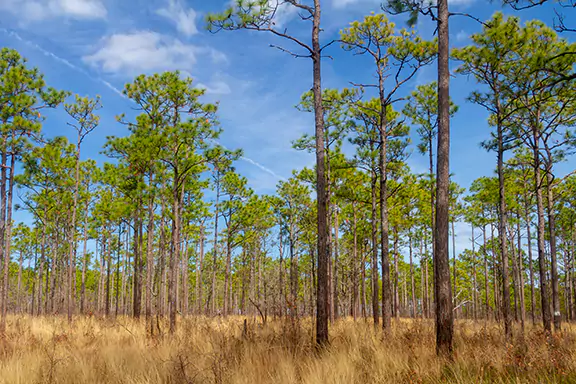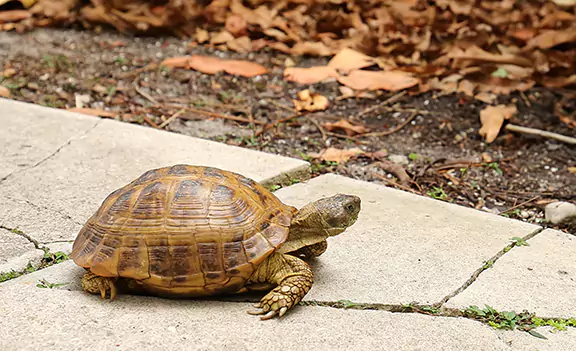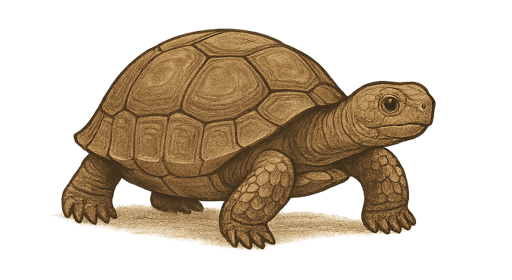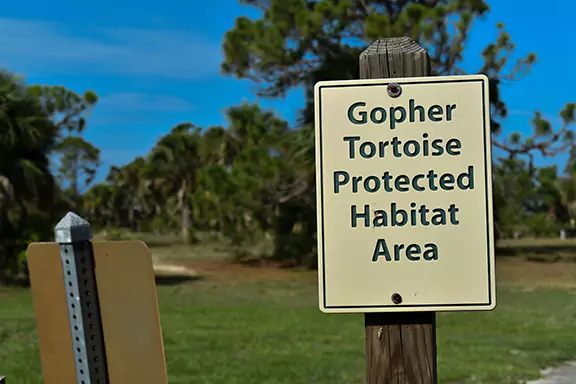Gopher tortoises (Gopherus polyphemus) are more than just slow-moving reptiles. They are a keystone species essential to the health of upland habitats across the southeastern United States. In Florida, these tortoises are legally protected, and disturbing them or their burrows can lead to serious consequences for landowners and developers. But before you worry about legal fines, it’s important to understand gopher tortoise habitat, because that’s where it all begins.
If you’re a private landowner or managing a commercial project in Florida, knowing whether your land supports gopher tortoises is the first critical step. This article will help you identify potential gopher tortoise habitat, explain why these tortoises are protected, and clarify what you must do if you find one on your property.

Where Gopher Tortoises Live: Identifying Habitat Across the Southeast
Gopher tortoises are native to the southeastern coastal plain, with a range that stretches from South Carolina and Georgia through peninsular Florida, including the Florida Panhandle. They prefer environments with sandy soils, abundant sunlight, and low-growing vegetation features typically found in the following habitat types:
Longleaf Pine Forests
Once widespread across the Southeast, longleaf pine ecosystems are now considered one of the most endangered habitats in North America. These open, sunlit woodlands with sandy ground and few mid-story shrubs are ideal for gopher tortoises. The prescribed fire regime historically used in longleaf systems helps maintain the sparse undergrowth and plant diversity that tortoises depend on.
Pine Flatwoods and Sandhill Ecosystems
Pine flatwoods, another common tortoise habitat in Florida, have a flatter topography and seasonally wet conditions but still feature the sandy soils tortoises prefer. Sandhill environments characterized by rolling terrain and deep, well-drained sands are also prime habitat.
Other Upland Habitats
Gopher tortoises may also be found in scrub, dry prairies, and coastal dunes, as long as conditions include loose, well-drained soils and an open canopy. Areas with few grasses, sun exposure, and native herbaceous plants often support active burrows.
Why Gopher Tortoise Habitat Matters for Biodiversity and Conservation
Gopher tortoises don’t just live in these habitats, they help shape them. Their deep burrows, which can reach up to 40 feet in length, provide critical shelter for over 350 other species, including:
Gopher frogs
Eastern indigo snakes
Burrowing owls
Invertebrates and small mammals
This is why the gopher tortoise is considered a keystone species. Its presence supports the survival of many other animals that share the same ecosystem.
Protecting gopher tortoise habitat contributes directly to regional biodiversity, the preservation of natural resources, and the recovery of threatened or endangered species across the eastern range. Conservation programs such as the Gopher Tortoise Conservation Initiative and organizations like the Fish and Wildlife Service, Forest Service, and Longleaf Alliance work to safeguard these ecosystems through partnerships with private landowners, conservation easements, and habitat restoration.
Private Landowners Need to Be Alert
However, as residential and commercial development continues across Florida and the Southeast, it’s increasingly common for private land owners and project managers to encounter gopher tortoises or their burrows, either through natural tortoise movement or planned land use. Because these species are protected, even unintentional disturbance can result in fines, project delays, or compliance issues if proper FWC permitting isn’t in place.
That’s why it’s important for industry professionals to be aware of the presence of gopher tortoise habitat before breaking ground. Early evaluation not only protects native wildlife—it also protects your timeline, budget, and legal standing.
Florida Gopher Tortoise Laws: What You Need to Know About Legal Protections
In Florida, the gopher tortoise is classified as a state-listed Threatened species by the Florida Fish and Wildlife Conservation Commission (FWC). This designation grants the tortoise and its burrow strict legal protection under Chapter 68A-27 of the Florida Administrative Code.
State and Federal Protections
While gopher tortoises in Florida are currently protected at the state level, the eastern distinct population segment is being reviewed for potential listing under the federal Endangered Species Act. That means enforcement may increase in the future, especially in areas where gopher tortoise populations are isolated or in decline due to habitat loss, invasive species, or development.
Key legal facts:
It is illegal to harm, harass, capture, or relocate a gopher tortoise without a valid permit.
This includes any activity that affects the burrow, even if the tortoise itself is not visible.
Violations can result in hefty fines, project delays, and legal enforcement from FWC and potentially the Fish and Wildlife Service.
These laws apply to all landowners: private landowners, developers, municipalities, and agricultural operations across the eastern range of the gopher tortoise, especially in Florida, Georgia, South Carolina, Alabama, and parts of Mississippi.

Burrows Are Protected Too: Why Disturbing Them Can Lead to Legal Trouble
Gopher tortoises are known for their distinctive elephantine hind feet and their ability to dig deep burrows into sandy soils. These burrows serve as refuge not only for the tortoise but for many other species, making them critical components of the longleaf pine ecosystem and upland habitats.
State and Federal Protections
Each burrow is considered a part of the tortoise’s occupied habitat and is protected whether or not the tortoise is present at the time of inspection. That’s because:
Gopher tortoises may rotate between several burrows
Juvenile tortoises may use abandoned or smaller burrows
The burrows shelter many species, including some federally protected ones
Common penalties for unpermitted disturbance of burrows can include:
Fines up to $500 per violation (or more for repeat or intentional offenses)
Mandatory restoration of disturbed habitat
Potential halt of development activities until compliance measures are met
If you’re preparing to build or clear land in a tortoise habitat, it’s critical to conduct a Survey & Mapping site inspection first. This helps determine whether active or inactive burrows are present and what your next steps must be under Florida law.
Laws That Impact Landowners and Developers in Gopher Tortoise Habitat
If you own or manage land in Florida, especially within the known gopher tortoise range, development activities like clearing, grading, or construction may require permitting from the Florida Fish and Wildlife Conservation Commission (FWC).
When Is a Permit Required?
A permit is typically required if:
Gopher tortoise burrows are present in the project area
The land is within known gopher tortoise habitat, such as pine flatwoods, longleaf pine forests, or scrub with sandy soils
Construction or land use changes may impact the tortoise or its burrow, including roads, utilities, or site preparation
Steps to Ensure Legal Compliance
Hire a qualified wildlife agent to conduct a gopher tortoise survey
If burrows are found, determine whether they are active or inactive
Apply for the appropriate FWC relocation permit if needed
Relocate any tortoises following FWC guidelines to an approved recipient site
Why Early Action Matters
Failure to account for gopher tortoises early in the planning process can delay construction, increase costs, and result in legal penalties. Understanding the laws helps prevent conflict while supporting conservation.
Note: Relocation costs vary based on the number of active burrows, land area, and distance to recipient sites. An early site inspection is the most effective way to estimate costs and compliance needs.

What to Do If You Encounter a Gopher Tortoise on Your Property
Finding a gopher tortoise or burrow on your land doesn’t mean your project is over, it just means you need to take responsible, legal steps.
Is It Illegal to Move a Gopher Tortoise?
Yes. Under Florida law, you cannot:
Pick up or handle a gopher tortoise
Cover, fill, collapse, or dig near a burrow
Attempt to relocate a tortoise without a permit
Even unintentional harm, like driving heavy equipment over a burrow, can result in violations.
Here’s What You Should Do:
Mark the area to avoid further disturbance
Do not touch the tortoise or its burrow
Contact a licensed gopher tortoise agent to inspect the site
Work with the agent to develop a permitting and relocation plan if needed
Following these steps protects not only the tortoise but also your project timeline, your budget, and your legal standing.
Protecting Habitat While Protecting Your Project
Gopher tortoises are a vital part of Florida’s natural heritage. They support hundreds of other species and serve as indicators of healthy ecosystems, such as the longleaf pine forests, pine flatwoods, and upland habitats found throughout the southeastern coastal plain.
Understanding the connection between gopher tortoise habitat and Florida gopher tortoise laws isn’t just about conservation, it’s about compliance, planning, and avoiding costly missteps. Whether you’re developing a residential neighborhood, expanding agricultural land, or managing private property, recognizing the signs of gopher tortoise presence and acting early is critical.
Disturbing a tortoise or its burrow, intentionally or not, can lead to serious fines, delays, and legal consequences. But with the right guidance and proper permitting, it’s entirely possible to move forward with your project legally and responsibly.
Here’s What You Should Do:
If you suspect your land may contain gopher tortoises or their burrows, or you’re planning development in a known habitat area.
We provide expert site evaluations, handle all aspects of gopher tortoise permitting, and manage safe, authorized relocation to FWC-approved recipient sites.
Let’s ensure your project moves forward without setbacks, surprises, or violations.

